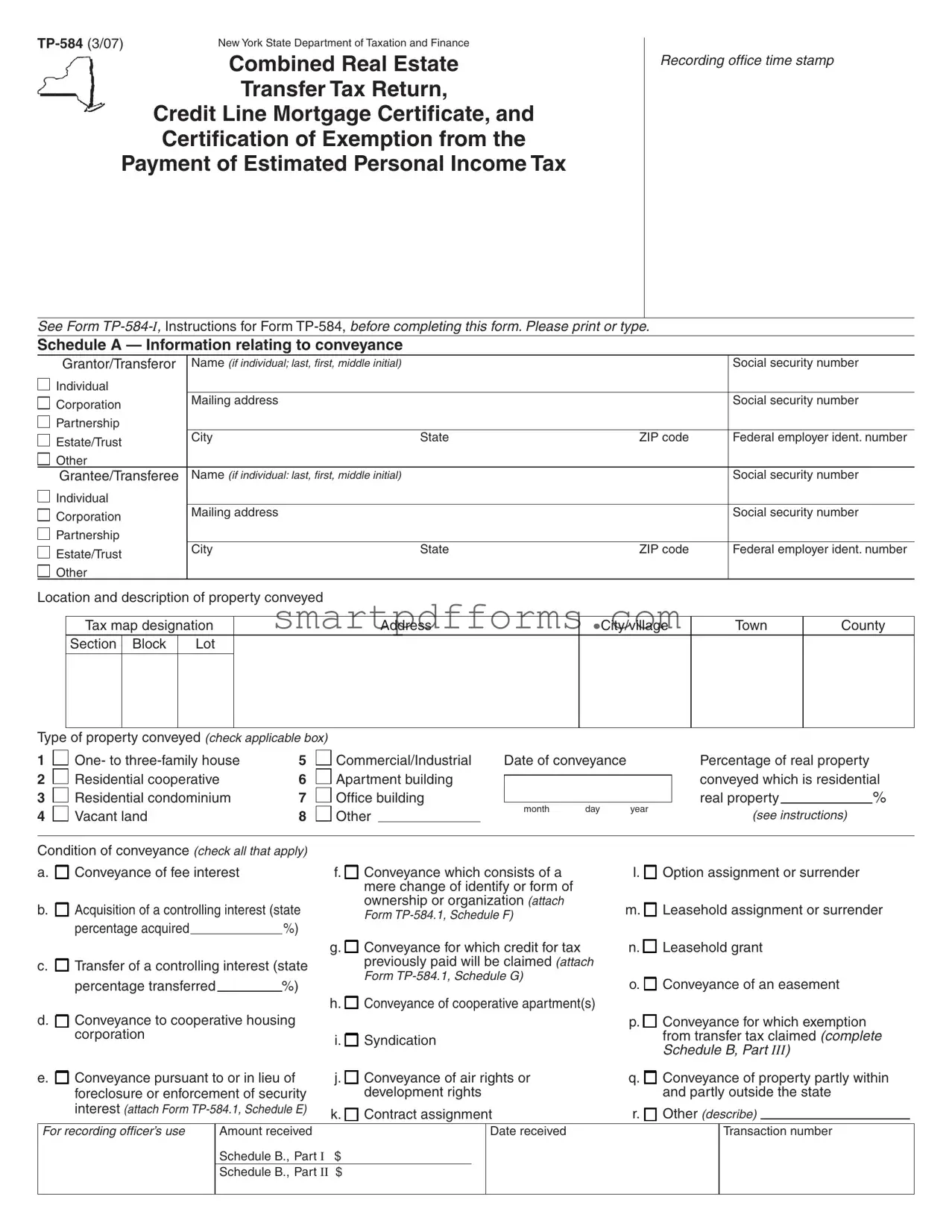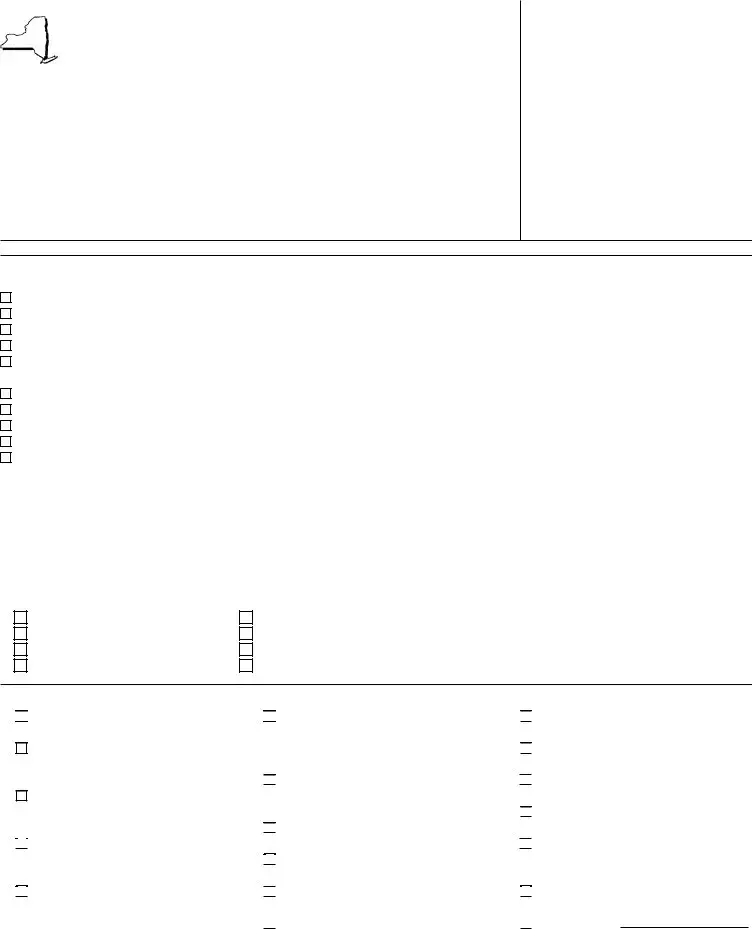TP-584 (3/07)New York State Department of Taxation and Finance
Combined Real Estate
Transfer Tax Return,
Credit Line Mortgage Certificate, and
Certification of Exemption from the
Payment of Estimated Personal Income Tax
Recording office time stamp
See Form TP-584-I, Instructions for Form TP-584, before completing this form. Please print or type.
Schedule A — Information relating to conveyance
Grantor/Transferor |
Name (if individual; last, first, middle initial) |
|
|
Social security number |
Individual |
|
|
|
|
|
|
|
Corporation |
Mailing address |
|
|
|
Social security number |
|
|
|
|
|
|
|
Partnership |
|
|
|
|
|
|
|
Estate/Trust |
City |
State |
ZIP code |
|
Federal employer ident. number |
|
|
|
|
|
|
|
Other |
|
|
|
|
|
|
|
Grantee/Transferee |
Name (if individual: last, first, middle initial) |
|
|
Social security number |
Individual |
|
|
|
|
|
|
|
Corporation |
Mailing address |
|
|
|
Social security number |
|
|
|
|
|
|
|
Partnership |
|
|
|
|
|
|
|
Estate/Trust |
City |
State |
ZIP code |
|
Federal employer ident. number |
|
|
|
|
|
|
|
Other |
|
|
|
|
|
|
|
Location and description of property conveyed |
|
|
|
|
|
|
|
|
|
|
|
|
|
|
Tax map designation |
|
Address |
City/village |
|
Town |
County |
|
Section |
Block |
|
Lot |
|
|
|
|
|
|
|
|
|
|
|
|
|
|
|
|
|
Type of property conveyed (check applicable box)
1 |
One- to three-family house |
5 |
2 |
Residential cooperative |
6 |
3 |
Residential condominium |
7 |
4 |
Vacant land |
8 |
Commercial/Industrial |
Date of conveyance |
|
Apartment building |
|
|
|
|
|
|
Office building |
|
|
|
Other |
|
|
month |
day |
year |
|
|
|
Percentage of real property conveyed which is residential
(see instructions)
Condition of conveyance (check all that apply)
a.  Conveyance of fee interest
Conveyance of fee interest
b. |
|
Acquisition of a controlling interest (state |
|
|
percentage acquired |
|
|
%) |
c. |
|
Transfer of a controlling interest (state |
|
|
|
percentage transferred |
%) |
|
|
|
|
|
|
d. Conveyance to cooperative housing corporation
Conveyance to cooperative housing corporation
e. Conveyance pursuant to or in lieu of foreclosure or enforcement of security interest (attach Form TP-584.1, Schedule E)
Conveyance pursuant to or in lieu of foreclosure or enforcement of security interest (attach Form TP-584.1, Schedule E)
f.  Conveyance which consists of a mere change of identify or form of ownership or organization (attach
Conveyance which consists of a mere change of identify or form of ownership or organization (attach
Form TP-584.1, Schedule F)
g. 
 Conveyance for which credit for tax previously paid will be claimed (attach
Conveyance for which credit for tax previously paid will be claimed (attach
Form TP-584.1, Schedule G)
h. 
 Conveyance of cooperative apartment(s)
Conveyance of cooperative apartment(s)
i. 
 Syndication
Syndication
j. 
 Conveyance of air rights or development rights
Conveyance of air rights or development rights
k. 
 Contract assignment
Contract assignment
For recording officer’s use |
Amount received |
|
|
Date received |
Transaction number |
|
Schedule B., Part I |
$ |
|
|
|
|
Schedule B., Part II |
$ |
|
|
|
|
|
|
|
|
|
Page 2 of 4 TP-584 (3/07)
Schedule B — Real estate transfer tax return (Tax Law, Article 31)
Part I – Computation of tax due
1Enter amount of consideration for the conveyance (if you are claiming a total exemption from tax, check the
|
exemption claimed box, enter consideration and proceed to Part III) |
|
Exemption claimed |
2 |
Continuing lien deduction (see instructions if property is taken subject to mortgage or lien) |
......................................... |
|
3 |
Taxable consideration (subtract line 2 from line 1) |
|
|
4 |
Tax: $2 for each $500, or fractional part thereof, of consideration on line 3 |
|
|
5 |
Amount of credit claimed (see instructions and attach Form TP-584.1, Schedule G) |
|
|
6 |
Total tax due* (subtract line 5 from line 4) |
|
|
Part II – Computation of additional tax due on the conveyance of residential real property for $1 million or more
1 Enter amount of consideration for conveyance (from Part I, line 1) ........................................................................
2 Taxable consideration (multiply line 1 by the percentage of the premises which is residential real property, as shown in Schedule A) ...
3 Total additional transfer tax due* (multiply line 2 by 1% (.01)) ..................................................................................
Part III – Explanation of exemption claimed on Part I, line 1 (check any boxes that apply)
The conveyance of real property is exempt from the real estate transfer tax for the following reason:
1.
2.
3.
4.
5.
6.
1.
2.
3.
a.Conveyance is to the United Nations, the United States of America, the state of New York, or any of their instrumentalities, agencies, or political subdivisions (or any public corporation, including a public corporation created pursuant to agreement or
compact with another state or Canada) |
a |
b. Conveyance is to secure a debt or other obligation |
b |
c. Conveyance is without additional consideration to confirm, correct, modify, or supplement a prior conveyance |
c |
d. Conveyance of real property is without consideration and not in connection with a sale, including conveyances conveying |
|
realty as bona fide gifts |
d |
e. Conveyance is given in connection with a tax sale |
e |
f.Conveyance is a mere change of identity or form of ownership or organization where there is no change in beneficial ownership. (This exemption cannot be claimed for a conveyance to a cooperative housing corporation of real property
comprising the cooperative dwelling or dwellings.) Attach Form TP-584.1, Schedule F |
f |
g. Conveyance consists of deed of partition |
g |
h. Conveyance is given pursuant to the federal Bankruptcy Act |
h |
i. Conveyance consists of the execution of a contract to sell real property, without the use or occupancy of such property, or |
|
the granting of an option to purchase real property, without the use or occupancy of such property |
i |
j.Conveyance of an option or contract to purchase real property with the use or occupancy of such property where the consideration is less than $200,000 and such property was used solely by the grantor as the grantor’s personal residence and consists of a one-, two-, or three-family house, an individual residential condominium unit, or the sale of stock
in a cooperative housing corporation in connection with the grant or transfer of a proprietary leasehold covering an
individual residential cooperative apartment |
j |
k. Conveyance is not a conveyance within the meaning of Tax Law, Article 31, section 1401(e) (attach documents |
|
supporting such claim) |
k |
l. Other (attach explanation) |
l |
*Please make check(s) payable to the county clerk where the recording is to take place. If the recording is to take place in New York City, make check(s) payable to the NYC Department of Finance. If a recording is not required, send this return and your check(s) made payable to the NYS Department of Taxation and Finance, directly to the NYS Tax Department, RETT Return Processing, PO Box 5045, Albany NY 12205-5045.
Page 3 of 4 TP-584 (3/07)
Schedule C — Credit Line Mortgage Certificate (Tax Law, Article 11)
Complete the following only if the interest being transferred is a fee simple interest.
I (we) certify that: (check the appropriate box)
The real property being sold or transferred is not subject to an outstanding credit line mortgage.
The real property being sold or transferred is subject to an outstanding credit line mortgage. However, an exemption from the tax is claimed for the following reason:
The transfer of real property is a transfer of a fee simple interest to a person or persons who held a fee simple interest in the real property (whether as a joint tenant, a tenant in common or otherwise) immediately before the transfer.
The transfer of real property is (A) to a person or persons related by blood, marriage or adoption to the original obligor or to one or more of the original obligors or (B) to a person or entity where 50% or more of the beneficial interest in such real property after the transfer is held by the transferor or such related person or persons (as in the case of a transfer to a trustee for the benefit of a minor or the transfer to a trust for the benefit of the transferor).
The transfer of real property is a transfer to a trustee in bankruptcy, a receiver, assignee, or other officer of a court.
The maximum principal amount secured by the credit line mortgage is $3,000,000 or more, and the real property being sold or transferred is not principally improved nor will it be improved by a one- to six-family owner-occupied residence or dwelling.
Please note: for purposes of determining whether the maximum principal amount secured is $3,000,000 or more as described above, the amounts secured by two or more credit line mortgages may be aggregated under certain circumstances. See TSB-M-96(6)-R for more information regarding these aggregation requirements.
Other (attach detailed explanation).
The real property being transferred is presently subject to an outstanding credit line mortgage. However, no tax is due for the following reason:
A certificate of discharge of the credit line mortgage is being offered at the time of recording the deed.
A check has been drawn payable for transmission to the credit line mortgagee or his agent for the balance due, and a satisfaction of such mortgage will be recorded as soon as it is available.
The real property being transferred is subject to an outstanding credit line mortgage recorded in
(insert liber and page or reel or other identification of the mortgage). The maximum principal amount of debt or obligation secured
by the mortgage is. No exemption from tax is claimed and the tax of
is being paid herewith. (Make check payable to county clerk where deed will be recorded or, if the recording is to take place in New York City, make check payable to the NYC Department of Finance.)
Signature (both the grantor(s) and grantee(s) must sign)
The undersigned certify that the above information contained in schedules A, B, and C, including any return, certification, schedule, or attachment, is to the best of his/her knowledge, true and complete, and authorize the person(s) submitting such form on their behalf to receive a copy for purposes of recording the deed or other instrument effecting the conveyance.
Grantor signature |
Title |
Grantee signature |
Title |
Grantor signature |
Title |
Grantee signature |
Title |
Reminder: Did you complete all of the required information in Schedules A, B, and C? Are you required to complete Schedule D? If you checked e, f, or g in Schedule A, did you complete Form TP-584.1? Have you attached your check(s) made payable to the county clerk where recording will take place or, if the recording is in New York City, to the NYC Department of Finance? If no recording is required, send your check(s), made payable to the Department of Taxation and Finance, directly to the NYS Tax Department, RETT Return Processing, PO Box 5045, Albany NY 12205-5045.
Page 4 of 4 TP-584 (3/07)
Schedule D - Certification of exemption from the payment of estimated personal income tax (Tax Law, Article 22, section 663)
Complete the following only if a fee simple interest or a cooperative unit is being transferred by an individual or estate or trust.
Part I - New York State residents
If you are a New York State resident transferor(s)/seller(s) listed in Schedule A of Form TP-584 (or an attachment to Form TP-584), you must sign the certification below. If one or more transferors/sellers of the real property or cooperative unit is a resident of New York State, each resident transferor/seller must sign in the space provided. If more space is needed, please photocopy this Schedule D and submit as many schedules as necessary to accommodate all resident transferors/sellers.
Certification of resident transferor(s)/seller(s)
This is to certify that at the time of the sale or transfer of the real property or cooperative unit, the transferor(s)/seller(s) as signed below was a resident of New York State, and therefore is not required to pay estimated personal income tax under Tax Law, section 663(a) upon the sale or transfer of this real property or cooperative unit.
Signature |
Print full name |
Date |
|
|
|
Signature |
Print full name |
Date |
|
|
|
Signature |
Print full name |
Date |
|
|
|
Signature |
Print full name |
Date |
|
|
|
Note: A resident of New York State may still be required to pay estimated tax under Tax Law, section 685(c), but not as a condition of recording a deed.
Part II - Nonresidents of New York State
If you are a nonresident of New York State listed as a transferor/seller in Schedule A of Form TP-584 (or an attachment to Form TP-584) but are not required to pay estimated personal income tax because one of the exemptions below applies under Tax Law, section 663(c), check the box of the appropriate exemption below. If any one of the exemptions below applies to the transferor(s)/seller(s), that transferor(s)/seller(s) is not required to pay estimated personal income tax to New York State under Tax Law, section 663. Each nonresident transferor/seller who qualifies under one of the exemptions below must sign in the space provided. If more space is needed, please photocopy this Schedule D and submit as many schedules as necessary to accommodate all nonresident transferors/sellers.
If none of these exemption statements apply, you must complete Form IT-2663, Nonresident Real Property Estimated Income Tax Payment Form, or Form IT-2664, Nonresident Cooperative Unit Estimated Income Tax Payment Form. For more information, see Payment of estimated personal income tax, on page 1 of Form TP-584-I.
Exemption for nonresident transferor(s)/seller(s)
This is to certify that at the time of the sale or transfer of the real property or cooperative unit, the transferor(s)/seller(s) (grantor) of this real property or cooperative unit was a nonresident of New York State, but is not required to pay estimated personal income tax under Tax Law, section 663 due to one of the following exemptions:
The real property or cooperative unit being sold or transferred qualifies in total as the transferor’s/seller’s principal residence
(within the meaning of Internal Revenue Code, section 121) from |
|
to |
|
(see instructions). |
|
|
|
Date |
|
Date |

 The transferor/seller is a mortgagor conveying the mortgaged property to a mortgagee in foreclosure, or in lieu of foreclosure with no additional consideration.
The transferor/seller is a mortgagor conveying the mortgaged property to a mortgagee in foreclosure, or in lieu of foreclosure with no additional consideration.

 The transferor or transferee is an agency or authority of the United States of America, an agency or authority of the state of New York, the Federal National Mortgage Association, the Federal Home Loan Mortgage Corporation, the Government National Mortgage Association, or a private mortgage insurance company.
The transferor or transferee is an agency or authority of the United States of America, an agency or authority of the state of New York, the Federal National Mortgage Association, the Federal Home Loan Mortgage Corporation, the Government National Mortgage Association, or a private mortgage insurance company.
Signature |
Print full name |
Date |
|
|
|
Signature |
Print full name |
Date |
|
|
|
Signature |
Print full name |
Date |
|
|
|
Signature |
Print full name |
Date |
|
|
|


 Conveyance of fee interest
Conveyance of fee interest Conveyance to cooperative housing corporation
Conveyance to cooperative housing corporation
 Conveyance which consists of a mere change of identify or form of ownership or organization
Conveyance which consists of a mere change of identify or form of ownership or organization 
 Conveyance for which credit for tax previously paid will be claimed
Conveyance for which credit for tax previously paid will be claimed 
 Conveyance of cooperative apartment(s)
Conveyance of cooperative apartment(s)
 Syndication
Syndication
 Conveyance of air rights or development rights
Conveyance of air rights or development rights
 Contract assignment
Contract assignment
 Option assignment or surrender
Option assignment or surrender
 Leasehold assignment or surrender
Leasehold assignment or surrender
 Leasehold grant
Leasehold grant
 Conveyance of an easement
Conveyance of an easement
 Conveyance for which exemption from transfer tax claimed
Conveyance for which exemption from transfer tax claimed  Conveyance of property partly within and partly outside the state
Conveyance of property partly within and partly outside the state
 Other
Other 



 The transferor/seller is a mortgagor conveying the mortgaged property to a mortgagee in foreclosure, or in lieu of foreclosure with no additional consideration.
The transferor/seller is a mortgagor conveying the mortgaged property to a mortgagee in foreclosure, or in lieu of foreclosure with no additional consideration.
 The transferor or transferee is an agency or authority of the United States of America, an agency or authority of the state of New York, the Federal National Mortgage Association, the Federal Home Loan Mortgage Corporation, the Government National Mortgage Association, or a private mortgage insurance company.
The transferor or transferee is an agency or authority of the United States of America, an agency or authority of the state of New York, the Federal National Mortgage Association, the Federal Home Loan Mortgage Corporation, the Government National Mortgage Association, or a private mortgage insurance company.